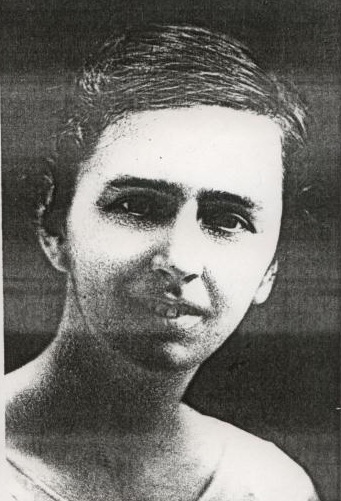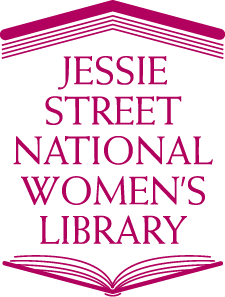Tapestry series no. 6
Contributed by Barbara Briggs (modified 24.6.1996)
Among Edna Briggs’s chief characteristics were her interest in science and knowledge, her strong social concern, and the way she supported others — especially her husband and daughters — at times at the expense of the fulfilment of some of her own hopes.
Edna Sayce was born in Melrose, South Australia, daughter of Alfred Richard Sayce and Ellen Sayce (née Dyke), but soon the family moved to Crafers in the Adelaide Hills. This was an idealistic community that started with aims of sharing and cooperation, with communal property. Indeed Alfred Sayce had intended joining a community of Australians with similar aims that moved to Paraguay but decided against this because of well-founded doubts as to whether its leader, William Lane, would succeed in managing the project. At Crafers Alfred had an orchard and market garden. Earlier he had done unemployment relief work as a carpenter building stations on the Oodnadatta railway line. Alfred had previously parted company from his family in Melbourne and was seen as something of an individualist or even a maverick not following the more ‘establishment’ types of career usual in his family. The Crafers community failed to keep to its original idealism, although Alfred and Ellen were among the last trying to keep these aims alive there.
When Edna was nine years old the family moved to Broken Hill and she was educated at the Broken Hill state school, gaining a Teachers’ College scholarship to Sydney University. Her early childhood may have been slightly lonely, with one considerably older sister and a father very deaf from industrial noise; reading became very important to her. Pleasure in reading, from English novelists (mostly not modern ones but H.G. Wells was an exception) to Greek tragedies and ancient history, was lifelong. With no singing voice, if her children could not sleep she would recite to them long poems learnt in her youth, mostly from the English romantic poets.
Her mother worked hard towards the establishment and development of a hospital at Broken Hill. Her sister Margaret remained for most of her life in Broken Hill, marrying Albert Morris and helping in his pioneering work in restoring vegetation around the city – with great improvement in living conditions as regeneration areas replaced the bare ground and dust storms that had been features of life there.
Coming to Sydney to take up the scholarship, Edna was very unsure how she would compete with students from city schools but she believed that physics was the area of science where the main understanding was being found. At the end of her first year, to her surprise, she topped the year in physics and went to see Professor Pollock about continuing in the subject. She took with her an item of carpentry -a small box- she had made, having learnt from her father, as an example of practical ability. ‘Why don’t you do geology? That is a better subject for a woman student’. Then ‘What was your first year exam result?’ ‘I came first.’ ‘Then, I don’t suppose I can stop you’. After that grudging acceptance she went on to become the first woman to graduate in physics from Sydney University (the next was nine years later). Study in Sydney meant the long train trip via Adelaide for holidays, except once when she travelled with the mail run through sparsely settled western NSW, being greeted in places as the first white woman visitor for months.
Finishing her course (B.Sc. Hons.) in 1917 there was a position available as a demonstrator/researcher for a year or two while many of the men students were on military service. She investigated and published on substances related to those now known as superconductors – but the significance of these materials was not realised till years later (a researcher in the 1980s commented that the one short paper that she published remained of some interest). The end of the war and return of ex-servicemen brought the end of her position. She was appointed as a lecturer at Sydney Teachers’ College and was also a resident tutor at Sydney University Women’s College.
On 8th January 1923 Edna married George Henry Briggs, then a lecturer in the Physics Department. George was the only child of a stonemason who had died while his son was quite young, leaving his widow reasonably comfortably provided for. Before settling to stonemasonry, William Briggs had carried his swag around the Australian goldfields after a brief stint at the Californian goldfields.
George had not done military service. He was in an exempt category as the only son of a widow and further exempt then as a university student. Sadly, concern that he was thought to be a shirker in World War I returned to haunt him much later as a frail ninety-year old. In World War II he was part of a Munitions Panel concerned with optical equipment such as gun-sights and travelled regularly between Sydney and Melbourne by train for meetings.
George, distinctly conservative, did not wish his wife to be in paid work and Edna abandoned her independent career and turned to assisting her husband in his research and in some of the time-consuming University matters so that he would be freer to get on with research. They must have been determined in pushing ahead with this work. George as a lecturer had personally employed a young technical assistant, probably before Edna’s help had been available. There were family stories of a Christmas dinner of chicken heated over a bunsen burner when the work was at a critical stage.
Her assistance in his work continued when in 1925 they went abroad to work at the Cavendish Laboratory at Cambridge with Rutherford (later Lord Rutherford, famous for the first splitting of the atom). The Cavendish was then the world centre for nuclear physics and the two years George and Edna spent there was the high point in their lives, and a vivid memory even in their old age. Women students were not then, I believe, accepted for degree courses but Edna was allowed to attend many lecture courses by the outstanding physicists (not all good lecturers) who came to the Laboratory, as well as the afternoon teas at home that the Rutherfords extended to their research students. George was on a sabbatical from Sydney University and managed to have his leave extended for long enough to gain a Ph.D. at Cambridge. Later he was awarded a D.Sc. for further research after returning to Sydney. Soon after their return from England, a meeting of the Australian and New Zealand Association for the Advancement of Science (ANZAAS) was held in Sydney and Edna presented a talk on the new developments in nuclear physics, bringing information from the cutting edge to the Australian scientific community.
Edna’s help in research was still in evidence when in 1939 George became Officer-in-Charge of the Division of Physics in CSIR (later CSIRO). This was the pattern of her life until the birth of their daughters (1933 and 1934) and until the need for science teachers during World War II gave her an ‘excuse’ to join the workforce again. She then enthusiastically taught high school science at Trinity Grammar School for some years. Later a former student spoke of her teaching as having a strong and positive impact. For George the administrative work of the new Division very largely put an end to his research career until after retirement. Then, as an Honorary Research Fellow, he attempted for years to return to some of his old research interests, but by then he lacked the ability and organisation to bring the work to completion, despite help and support from CSIRO colleagues. Edna’s strong tendency to underestimate her influence was occasionally unfortunate, as when she refused to attend George’s retirement dinner, feeling that it was not she that deserved to be celebrated and not appreciating the regard in which she and their founding Chief were held by his colleagues.
The delight in understanding and wide-ranging scientific curiosity that had led her to physics was imparted to many of the students she taught and to her two daughters, and was a basis for her encouragement and support of George in his scientific work throughout her life. Her example also inspired several younger cousins growing up in Broken Hill to obtain university education, leading to a range of worthwhile careers.
Edna expressed her social concern in many ways, mostly very practical ones. While a student and later she had assisted with the social work of the Sydney University Settlement; she supported Quaker (Society of Friends) Service activities; during an early General Strike in London she volunteered at a soup kitchen; during and after World War II she assisted at a canteen mainly serving troops and returned servicemen in the Domain in Sydney. She helped later with fund-raising for an Aboriginal training centre, Tranby, and a Leisure Centre at Friends Meeting House at Devonshire Street.
Edna’s Quaker faith was important through her life, although George, brought up as an Anglican, took an agnostic position.
She was a feminist in having been a pioneer herself academically and encouraging other women and her daughters and often impressed people as a fairly strong personality with definite views. But she mostly took self-effacing roles. For instance at winter Sports Days or Fete Days at her daughters’ school she always volunteered for the behind-the-scene role of making many litres of soup for sale, rather than taking a higher-profile position. She took an interest in women’s affairs in Women’s World Day of Prayer and in the Women Graduates’ Association. She was President of Sydney University Women Graduates’ Association when new universities were developing in Sydney and took the initiative of encouraging the Association to change its name and its charter to extend to all women graduates, a change that succeeded despite some opposition. She disliked the social stratification she found in England and partly for this reason chose State schools for her daughters.
Edna had a strong interest in nature and was fortunate to have a generally healthy constitution, up to her last years. With George she climbed mountains in Tasmania, bush-walked in the Blue Mountains, accompanied many trout fishing and camping trips in the NSW tablelands, toured widely in Australia and developed a bush garden after moving to a retirement village at Forestville.
The most difficult times may have been her last years but also when George was an adviser to the United Nations Atomic Energy Commission in New York during 1946 and 1947 and she stayed in Sydney so that their daughters’ schooling was not disrupted. Also World War II broke out while they were abroad again near London and she and the children returned by ship – in a wartime convoy and on short rations for the first stage – while George remained longer in England for his work. Much later, aged 70 and after a major operation and heart attack, she asked for tour brochures and – in hospital – planned taking a bus trip to Central Australia, a trip they did make. The same spirit was crucial when in the last years they successfully moved into a retirement hostel at a stage when doctors doubted that George –beset by severe anxiety and confusion– could manage except in a nursing home, although he partially recovered and eventually outlived her. She died aged 88; he lived to 94. In those difficult last years and in the months of her painful final illness (meningioma) the same spirit that she had always shown was especially important.
Edna’s legacy includes her place as a pioneer for women in Physics in Australia; in the tremendous support that she gave George Briggs towards his research and his role as foundation Chief of the CSIRO Division of Physics; her daughters Margaret Jocelyn Wright (Honours Physics graduate and electronmicroscopist, now a social worker in Manchester, England, wife of (Dr) Ian Francis Wright a nuclear physicist at Manchester University and with children Alison, Colin and Derek) and (Dr) Barbara Gillian Briggs (Botanist, Senior Assistant Director at the Royal Botanic Gardens, Sydney); and the effective support that she gave to many people and organisations, mostly in ways of very practical social concern for others.
Barbara Briggs
2 October 1991
with additions 10 October 1997 [By then Margaret, Ian Wright and Barbara had retired from the work indicated above, although Barbara continued as an Honorary Research Associate of Sydney’s Botanic Gardens] and further additions 4 March 2002 and 6 June 2006.


